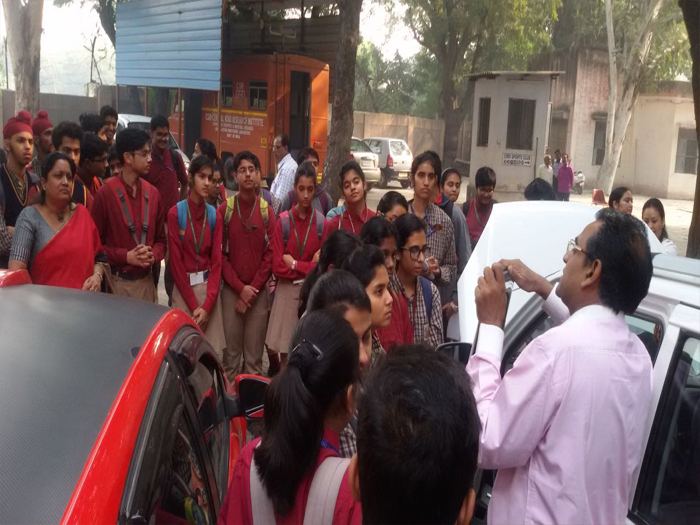CSIR- CRRI Visit for class 11 (Science)
Forty- five science students from class 11 participated in an open workshop held at the CSIR- Central Road Research Institute (CRRI), a premier national laboratory established in 1952, on 11th November 2016. They were accompanied by Ms. Anu Rana, Ms. Archana Raichandani and Ms. Namrata Jit Kaur from School.
The students were first given a basic idea about the functions and importance of CRRI in the CV Raman Conference Hall. CRRI is one of the 39 national laboratories of CSIR (Council of Scientific and Industrial Research). It is engaged in carrying out research and development projects on design, construction and maintenance of roads and runways, traffic and transportation planning of mega and medium cities, management of roads in different terrains, improvement of marginal materials, utilization of industrial waste in road construction, landslide control, ground improvements environmental pollution, road traffic safety and analysis and design, wind, fatigue, corrosion studies, performance monitoring/ evaluation, service life assessment and rehabilitation of highway and railway bridges.
[gallery link="file"]
The students were then shown various labs of the institute. The Driver Testing and Evaluation Lab tested the visual and motor skills of drivers.
Mr. Pradeep Kumar, head of the environment science division, next showed us the mobile air pollution monitoring lab used to measure the contribution of vehicular emissions to Delhis deteriorating air quality. The toughest part is to distinguish vehicular emissions from other air pollutants. While emissions containing sulphur are not vehicular, NOx (Nitrogen Oxide) emissions relate to diesel emissions, and oxides of carbon in the air indicate the amount of emissions from vehicles using petrol. Vehicular emissions make about 70% of CO (Carbon Monoxide) emissions in the air. The department had also analyzed around 350 vehicles to see the fuel consumption according to the change in speed, in order to design better cars. This analysis was possible due to a small, unassuming, but expensive (costing 1.5 lakh!) piece of technology called OBD (On- Board Diagnostics). OBD systems give the vehicle owner or repair technician access to the status of the various vehicle subsystems. Automatic cars were seen to be the most efficient.
We were then told about the various types of pavements. They mainly consist of bituminous and concrete pavements. Though the latter is far more durable, but its construction generates a lot of Carbon Dioxide. So scientists there are now modifying concrete pavements using waste materials to create fly ash concrete pavements. The thickness and material used to make pavements and roads are determined by two principal factors: load and environment. Roads are maintained according to the climate and terrain in which they are found. Even used metals and radioactive waste (harmful to a lesser degree) was being added to roads to make them robust. The centre runs tests to develop better materials for the construction of roads. The students were also told how roads were made waterproof to endure all kinds of weather.
The students were then shown the Automated Road Survey System, which was used by CRRI to understand the pathology of major roads throughout the country. It has laser sensors to collect the profile of roads: gradient, cross slope, horizontal curvature etc. The vehicle has ground penetrating radars and makes use of electromagnetic waves to detect the metallic utilities underground. The aim to conduct these surveys is to create a database on the condition of roads in India. Not only will this be an important part of PM Narendra Modis Digital India, but shall also check the haphazard maintenance of roads. In other words, the municipalities will not waste money by allocating funds for roads which are in good condition. The roads are given a rating by this vehicle which decides their rate of deterioration and hence prioritises their maintenance. This has been achieved in the state of Odisha, where no money is wasted on constructing roads unless asked to do so by the road survey organisations. This vehicle is quite expensive and is the only one in India at the moment. The institute is trying to replicate this vehicle as part of the Make in India initiative.
There was a quiz on General Science towards the end which lasted for an hour.
The trip to CRRI was very enlightening. Students were enthralled to know and see the science behind an integral part of Indian development: roads. Roads form a bridge to the India we all envision, connecting all parts of the nation. The quest for developing better roads continues at CRRI.
Saruby Sharma (Class XI ).













